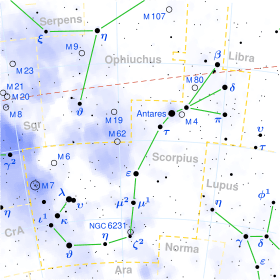Eta Scorpii
Eta Scorpii (η Sco, η Scorpii) is a star in the southern zodiac constellation of Scorpius. With an apparent visual magnitude of 3.33,[2] this is one of the brighter members of the Scorpius and is the furthest south of the constellation stars with a Bayer designation.[8] The distance to this star can be estimated using parallax measurements, yielding a value of 73.5 light-years (22.5 parsecs) with a 0.4% margin of error.[1]
 | |
| Observation data Epoch J2000 Equinox J2000 | |
|---|---|
| Constellation | Scorpius |
| Right ascension | 17h 12m 09.19565s[1] |
| Declination | –43° 14′ 21.0905″[1] |
| Apparent magnitude (V) | 3.33[2] |
| Characteristics | |
| Spectral type | F5 IV[3] |
| U−B color index | +0.09[2] |
| B−V color index | +0.41[2] |
| Astrometry | |
| Radial velocity (Rv) | –27.0[4] km/s |
| Proper motion (μ) | RA: +24.47[1] mas/yr Dec.: –288.55[1] mas/yr |
| Parallax (π) | 44.39 ± 0.16[1] mas |
| Distance | 73.5 ± 0.3 ly (22.53 ± 0.08 pc) |
| Absolute magnitude (MV) | +1.58[5] |
| Details | |
| Mass | 1.75[6] M☉ |
| Luminosity | 17.7[6] L☉ |
| Surface gravity (log g) | 3.10[3] cgs |
| Temperature | 6,519[3] K |
| Metallicity [Fe/H] | 0.05[5] dex |
| Rotational velocity (v sin i) | 150.0[6] km/s |
| Age | 1.1[5] Gyr |
| Other designations | |
| Database references | |
| SIMBAD | data |
The stellar classification of this star has undergone some revision over time, with the star being classified anywhere from an F-type main sequence star to a giant star.[7] In 2006, the NStars program assigned it a class of F5 IV,[3] where the luminosity class of 'IV' indicates this is a subgiant star that is exhausting the supply of hydrogen at its core and is in the process of evolving into a giant star. It has around 175%[6] of the Sun's mass with an estimated age of 1.1 billion years.[5] The star is radiating about 18[6] times the luminosity of the Sun from its outer atmosphere at an effective temperature of 6,519 K.[3] It is this heat that gives it a yellow-white hue that is typical for an F-type star.[9]
Eta Scorpii is rotating rapidly, with a projected rotational velocity of 150 km s−1.[6] This is causing the star to spin on its axis with a period of less than a day.[10] It is an X-ray emitter with its stellar corona giving off an X-ray luminosity of 4.4 × 1028 ergs s−1.[11] In 1991 it was identified as a possible barium star, as it displays an enhanced abundance of the element barium in its spectrum.[12] Overall, the abundance of elements other than hydrogen and helium, what astronomers term the star's metallicity, is similar to the abundance in the Sun.[5]
References
- van Leeuwen, F. (November 2007), "Validation of the new Hipparcos reduction", Astronomy and Astrophysics, 474 (2): 653–664, arXiv:0708.1752, Bibcode:2007A&A...474..653V, doi:10.1051/0004-6361:20078357
- Bok, B. J.; Bok, P. F.; Miller, E. W. (November 1972), "Photometric standards for the southern hemisphere. II", Astronomical Journal, 77: 733, Bibcode:1972AJ.....77..733B, doi:10.1086/111346
- Gray, R. O.; et al. (July 2006), "Contributions to the Nearby Stars (NStars) Project: Spectroscopy of Stars Earlier than M0 within 40 pc-The Southern Sample", The Astronomical Journal, 132 (1): 161–170, arXiv:astro-ph/0603770, Bibcode:2006AJ....132..161G, doi:10.1086/504637
- Evans, D. S. (June 20–24, 1966), Batten, Alan Henry; Heard, John Frederick (eds.), The Revision of the General Catalogue of Radial Velocities, University of Toronto: International Astronomical Union, Bibcode:1967IAUS...30...57E
- Holmberg, J.; Nordstrom, B.; Andersen, J. (July 2009). "The Geneva-Copenhagen survey of the solar neighbourhood. III. Improved distances, ages, and kinematics". Astronomy and Astrophysics. 501 (3): 941–947. arXiv:0811.3982. Bibcode:2009A&A...501..941H. doi:10.1051/0004-6361/200811191.
- Mallik, Sushma V.; Parthasarathy, M.; Pati, A. K. (October 2003), "Lithium and rotation in F and G dwarfs and subgiants", Astronomy and Astrophysics, 409: 251–261, Bibcode:2003A&A...409..251M, doi:10.1051/0004-6361:20031084
- "LTT 6848 -- High proper-motion Star", SIMBAD, Centre de Données astronomiques de Strasbourg, retrieved 2012-02-10
- Burnham, Robert (1978), Burnham's celestial handbook: an observer's guide to the universe beyond the solar system, Dover books explaining science, 3 (2nd ed.), Courier Dover Publications, p. 1675, ISBN 0-486-23673-0
- "The Colour of Stars", Australia Telescope, Outreach and Education, Commonwealth Scientific and Industrial Research Organisation, December 21, 2004, retrieved 2012-02-10
- Kaler, James B., "Eta Scorpii", Stars, University of Illinois, retrieved 2012-02-10
- Pizzolato, N.; Maggio, A.; Sciortino, S. (September 2000), "Evolution of X-ray activity of 1-3 Msun late-type stars in early post-main-sequence phases", Astronomy and Astrophysics, 361: 614–628, Bibcode:2000A&A...361..614P
- Lu, Phillip K. (June 1991), "Taxonomy of barium stars", Astronomical Journal, 101: 2229–2254, Bibcode:1991AJ....101.2229L, doi:10.1086/115845